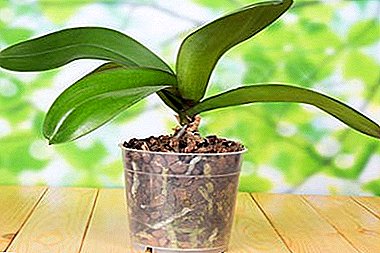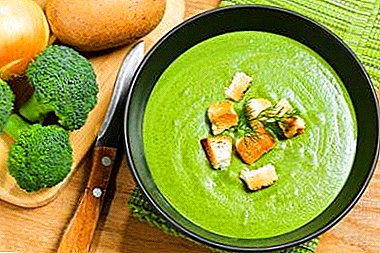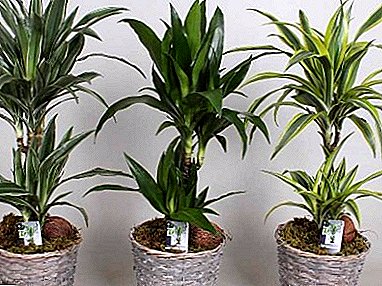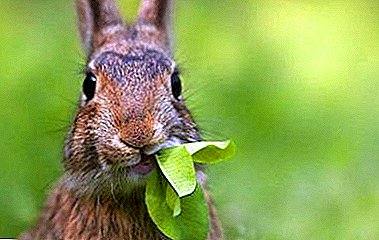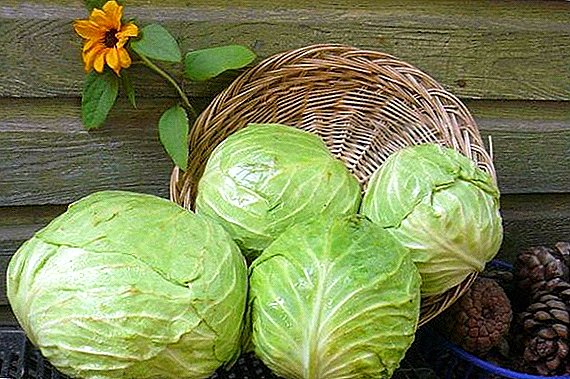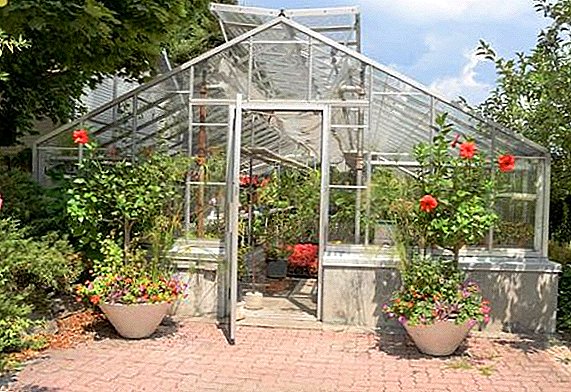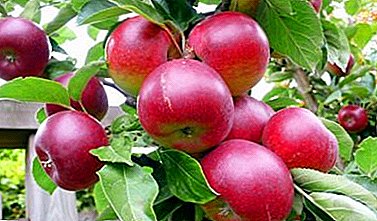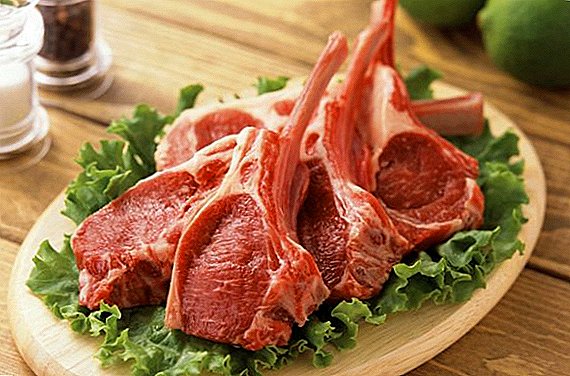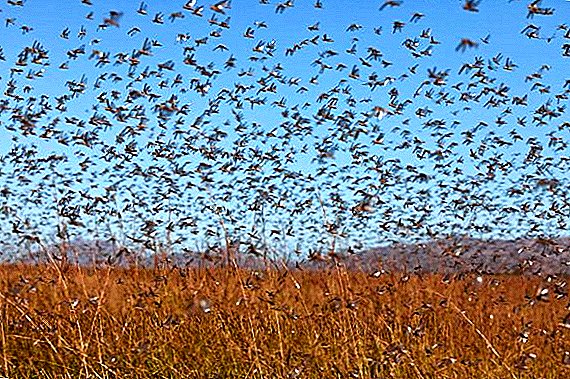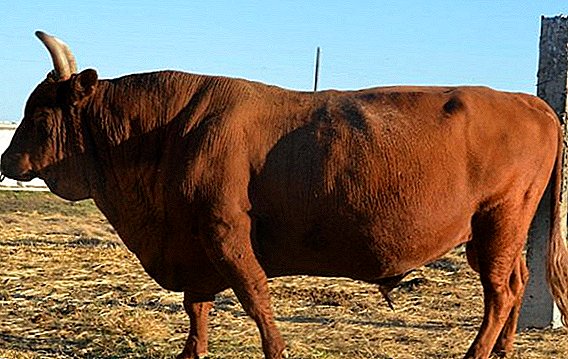 The bull-maker is the main jewel of the animal husbandry.
The bull-maker is the main jewel of the animal husbandry.
A healthy bull in many ways ensures the productivity of beef and dairy cattle.
Basic rules for the selection of producers bulls
The selection of gobies is carried out in two directions: the first is the line, the second is the family.  The essence of these areas is as follows:
The essence of these areas is as follows:
- Lines. Only the best bulls are used, which are called manufacturers.
- Families. The uterus with the highest rates is selected and families are created from them.
Did you know? The biggest bull is the chianine or porcelain bull. Adults he grows up to 1 m 80 cm at the withers with a weight of more than a ton.The most commonly used method of selection on the lines, selecting the best bulls.
The main selection criteria for the lines are:
- tribal qualities of "father" and "mother". For example, the "mother" is pedigree for at least four generations, having a developed udder with a yield of at least 150% of the standard indicators of its breed and a fat content of at least 0.2% of the norm. And the bull-maker from the "father" who has high-quality offspring, whose "daughters", according to the milk yield, belong to the A1 category and, according to the fat content of the milk, to the breeding category. And at the same time he should have outstanding external qualities and a constitution of at least 27 points;
- expressiveness and uniqueness of development. These indicators are checked by weighing when they come into the world, when they are transferred to a calf house, and then every month. When it is one year old - they are making a qualification, in which special attention is paid to the appearance and build of a bull - it must have a strong constitution and harmonious build;
- The quality of sperm. Estimated when a bull turns 12-14 months old. Certain requirements are imposed on the seed, which it must meet:
| Criterion | Requirements |
| Volume | At least 2 milliliters |
| Mass movement | +++ |
| Forward movement | 70% |
| Density | At least 600,000 sperm per milliliter |
| The percentage of deformed sperm | Less than 20% |
- quality of offspring. It is also checked when the animal is one year old. Ejaculate bull seeding two or three dozen cows. If more than half of the cows are fertilized, the bull is selected. Cash daughters of a bull are evaluated for quality when they are one and a half years old. The tribal value of a producer is determined by the difference in the productivity indices of his “daughters” (the milk yield should exceed the norm by 180%) and their other women of the same age.
Find out what should be the diet of the bull manufacturer.
Maintenance and care
Normal conditions of detention and proper care will significantly improve the reproductive ability of the bull, improve its health, and develop its genetic potential more intensively.  For the most convenient care for the breeding bull, it is recommended to adhere to the following schedule:
For the most convenient care for the breeding bull, it is recommended to adhere to the following schedule:
| No. p / p | Time | What to do |
| 1. | 4 hours-5 o'clock in the morning | early feeding |
| 2. | from 4 (5) hours to 7 hours | relaxation |
| 3. | 7 o'clock | cleaning the coat, scrotum and hoofs of a bull |
| 4. | from 7 hours to 10 hours | walking, copulation or chores |
| 5. | 10 hours | second feeding |
| 6. | from 10 hours to 16 hours | relaxation |
| 7. | from 4 pm to 7 pm | work or copulation |
| 8. | 19 hours - 21 hours | third feeding |
Walking
Daily long walking is one of the most important procedures for the care of a breeding animal. Physical activity supports the livelihoods of the manufacturer, strengthens his health and immunity to infectious diseases, prevents the occurrence of excess weight.
In addition, walking helps strengthen muscle and bone tissue.
Familiarize yourself with the most well-known species of bull-breeds of meat breed for fattening, and also find out what the horns are used for and grow from the bull.
The walking of a manufacturing bull should last at least three hours, and the pad for walking should have at least ten acres and be firmly fenced. Walking should be equipped with a canopy from the sun and rain, as well as drinking water.  For the convenience of walking the animal, a special strong ring is fastened in its nose, for which the bull is fixed during a walk.
For the convenience of walking the animal, a special strong ring is fastened in its nose, for which the bull is fixed during a walk.
Important! There should be no joint walking of sires with cows and calves.
Arranging a place for a bull
An individual fenced site with an area of 3.0-3.3 square meters, a width of one and a half meters and a depth of 2.0-2.2 m with partitions of two thirds of the length should be equipped for the animal.
Floor. The first coating - asphalt and concrete with a slope to the tray at 3-5 °, the second coating - wooden panels 1,5x2,5 with a zone of cracks in the middle third of the board; horizontal must be ensured by the construction.
If a tethered method of content is used, a two-end loose chain harness with a thick belt collar is used. The length of the leash is chosen from the calculation so that the bull can freely lie down.
Conditions of detention
The conditions of breeding bulls depend on their individual characteristics and temperament, for example, violent bulls can not be kept calm, but in our article we will talk about the basic rules and requirements for the conditions of keeping bulls-producers.  The place of keeping animals must meet the following requirements:
The place of keeping animals must meet the following requirements:
- Good light - darkness in the room can lead to atrophy of the sex glands. Natural lighting: (the ratio of the area of the glazing to the area of the floor) 1: 10-1: 15; artificial lighting (at the level of feeders) - 55-80 Lux.
- Air temperature - 10 ° С.
- Relative humidity: max - 75%, min - 40%.
- Air speed: cold season and off season - 0.3 m / s, warm time - 0.5 m / s.
- The maximum permissible concentration of poisonous gases: carbon dioxide - 0.25%, hydrogen nitride - 20 mg / cubic meter, dihydrosulfide - traces.
Did you know? The bull is color blind and unable to distinguish colors. On the bullfight, it is not the color of the rag that excites him, but the torero constantly waving something in front of him.
Care of the bull
Proper care, as well as normal conditions of detention, must be provided to the animal from an early age.
The main activities for the care of the bull-manufacturer include:
- Daily washing and cleaning with a brush and straw harness. The head requires special attention (occipital region, forehead and space between the horns). This will prevent the skin from having bulls. Too polluted animals wash with warm water and wipe dry. With an outdoor temperature of +20 ° C and more, bulls bathe in ponds or are washed with water from a hose.
- Systematic care for the hoofs. As they grow, they are periodically trimmed and cleaned from dirt. This is done two or three times a year to avoid injury to the animal.
- Periodic washing of the scrotum and foreskin of the bull with warm water followed by wiping with clean gauze. In order to prevent infection of the foreskin with a harmful effect on the ejaculate by microbes, once every ten days the prepuce is irrigated with a 3% solution of hydrogen peroxide or a 0.02% solution of nitrofural. This procedure maintains the purity and health of the genital organs of the manufacturer, which in the future will have a beneficial effect during copulation.

Regular cleaning of the stall and inventory
To ensure the health of the manufacturer in the stalls, it is necessary to maintain cleanliness and systematically disinfect. Disinfect with 2% caustic soda solution or hydrated lime. During this process, the animal is removed from the room.
Did you know? In Western Sumatra, bull races are regularly held.
It also disinfects inventory, items of care for the bull, packaging and tools.
The litter should be changed daily, and in case of heavy manure pollution, several times a day.
Features of feeding of bulls of producers: diet, norms, additives
Full feeding is a guarantee of the normal formation of the bull's reproductive system and the maturation of gametes. Disruptions in feeding, adding low-quality and unbalanced feeds to the diet worsen gamete production.
The diet of the animal should be rich in protein foods.
Daily producer's need for feed energy is not the same, it changes depending on the load on the bull.
Separately, it should be said about the additives to feeding animals. They are introduced into the diet in cases of lack of full plant rations and with increased sexual load. In winter, a positive effect on the quality of the ejaculate introduction into the diet of animal feed, vitamins and minerals.  Desirable additives in the form of blood, fish, meat and meat-bone meal, skimmed milk powder (50-400 g per day), skim milk (2-3 l), chicken eggs (3 to 5 pcs).
Desirable additives in the form of blood, fish, meat and meat-bone meal, skimmed milk powder (50-400 g per day), skim milk (2-3 l), chicken eggs (3 to 5 pcs).
Mineral salts, incl. table salt, phosphorus-containing supplements, salts of microelements are given according to the norms.
Did you know? The most horned bull in the world is a watusi bull. The span of its horns is from 1.5 to 2.4 meters.
For the purpose of vitamin balancing of different portions, the following are added:
- Irradiated fodder yeast.
- Wheatgrass.
- Sprouted corn and barley.
- Grass cutting.
- Herbal flour.
- Granules.
- Vitamin preparations of groups A, D, E.
The use of a dry concentrate of vitamin A (in 1g 500 000 IU), a concentrate of vitamin D2, preparations of vitamin D3 is also recommended.
In the non-random period
In non-random time, an ox bull needs 0.8-1.2 economic feed units per centner.  Rates of feeding the animal during this period are as follows:
Rates of feeding the animal during this period are as follows:
| Indicators | Live weight, kg | ||||||
| 600 | 700 | 800 | 900 | 1000 | 1100 | 1200 | |
| Energy feed unit | 7,0 | 7,8 | 8,4 | 9,1 | 9,7 | 10,2 | 10,8 |
| Exchange energy, MJ | 70 | 78 | 84 | 91 | 97 | 102 | 108 |
| Total substance, kg | 8,7 | 9,7 | 10,5 | 11,3 | 12,0 | 12,7 | 13,4 |
| Crude protein, g | 1010 | 1120 | 1205 | 1305 | 1385 | 1470 | 1550 |
| Digestible protein, g | 610 | 680 | 730 | 790 | 840 | 890 | 940 |
| Rumen-cleaved protein, g | 627 | 698 | 752 | 815 | 868 | 913 | 967 |
| Untransferable in the rumen protein, g | 383 | 422 | 453 | 490 | 517 | 567 | 583 |
| Lizin.g | 61 | 68 | 73 | 79 | 84 | 89 | 94 |
| Methionine, g | 31 | 34 | 37 | 40 | 41 | 45 | 47 |
| Tryptophan, g | 22 | 24 | 26 | 28 | 30 | 32 | 34 |
| Crude fiber, g | 2175 | 2425 | 2600 | 2825 | 3000 | 3175 | 3350 |
| Starch, g | 670 | 750 | 805 | 870 | 925 | 980 | 1035 |
| Sugar, g | 610 | 680 | 730 | 790 | 840 | 890 | 940 |
| Crude fat, g | 260 | 290 | 310 | 340 | 360 | 380 | 400 |
| Salt, g | 40 | 40 | 45 | 50 | 50 | 55 | 60 |
| Calcium, g | 40 | 40 | 45 | 50 | 50 | 55 | 60 |
| Phosphorus, g | 24 | 27 | 29 | 32 | 34 | 35 | 38 |
| Magnesium, g | 12 | 14 | 16 | 18 | 20 | 22 | 24 |
| Potassium, g | 60 | 70 | 80 | 90 | 100 | 110 | 120 |
| Sulfur, g | 18 | 21 | 24 | 27 | 30 | 33 | 36 |
| Iron mg | 480 | 535 | 570 | 620 | 660 | 700 | 740 |
| Copper mg | 85 | 90 | 100 | 110 | 115 | 120 | 130 |
| Zinc, mg | 350 | 390 | 415 | 450 | 480 | 510 | 535 |
| Cobalt mg | 6,5 | 7,3 | 7,8 | 8,5 | 9,0 | 9,5 | 10,1 |
| Manganese, mg | 435 | 485 | 520 | 565 | 600 | 635 | 670 |
| Iodine mg | 6.5 | 7.3 | 7.8 | 8.5 | 9.0 | 9.5 | 10.1 |
| Carotene mg | 350 | 390 | 415 | 450 | 500 | 550 | 600 |
| Vitamin D thousand ME | 7,2 | 8,4 | 9,6 | 10,8 | 12,0 | 13,2 | 14,4 |
| Vitamin E, mg | 260 | 290 | 310 | 340 | 360 | 380 | 400 |
| ECE concentration in 1 kg of dry matter | 0,80 | 0,80 | 0,80 | 0,80 | 0,80 | 0,80 | 0,80 |
| Digestible Protein on 1 EEC, g | 87 | 87 | 87 | 87 | 87 | 87 | 87 |
| Sugar-protein ratio | 1,0 | 1,0 | 1,0 | 1,0 | 1,0 | 1,0 | 1,0 |
In this period
Feeding during this period is differentiated depending on the load on the bull sementer. This will tell a little below. However, the general rule is to feed an animal after mating. 
With an average load (1 charge per week)
The recipe of the combined feed for a manufacturer in 1000 kg with an average load
| Component Name | Content% |
| Ground Corn | 16 |
| Rolled oats or barley | 25 |
| Wheat bran | 15 |
| Sunflower or soybean meal | 20 |
| Fish flour | 5 |
| Feed Yeast | 5 |
| Sugar, molasses | 10 |
| Feed phosphate | 1 |
| Salt | 1 |
| Mineral Vitamin Premix | 1 |
With increased load (2-3 charges per week)
During this period, a manufacturer weighing more than 1000 kg needs up to 15-18 economic feed units.  Below are the approximate norms of feeding one animal per day with increased load.
Below are the approximate norms of feeding one animal per day with increased load.
| Indicators | Live weight, kg | ||||||||
| 600 | 700 | 800 | 900 | 1000 | 1100 | 1200 | 1300 | 1400 | |
| Feed units | 7,8 | 8,7 | 9,3 | 10,1 | 10,8 | 11,4 | 12,0 | 12,5 | 12,9 |
| Exchange energy, MJ | 90 | 100 | 108 | 116 | 124 | 131 | 138 | 144 | 148 |
| Dry matter, kg | 9,2 | 10,2 | 10,9 | 11,9 | 12,7 | 13,4 | 14,1 | 14,7 | 15,2 |
| Crude protein, g | 1865 | 2008 | 2225 | 2415 | 2585 | 2725 | 2870 | 2990 | 3085 |
| Digestible protein, g | 1130 | 1260 | 1350 | 1465 | 1565 | 1655 | 1740 | 1815 | 1870 |
| Crude fiber, g | 1840 | 2040 | 2180 | 2380 | 2540 | 2680 | 2820 | 2940 | 3040 |
| Starch, g | 1245 | 1390 | 1485 | 1610 | 1725 | 1820 | 1915 | 1995 | 2055 |
| Sugar, g | 1130 | 1260 | 1350 | 1465 | 1565 | 1655 | 1740 | 1815 | 1870 |
| Crude fat, g | 370 | 410 | 440 | 480 | 510 | 540 | 565 | 590 | 610 |
| Table salt, g | 55 | 60 | 65 | 70 | 75 | 80 | 85 | 90 | 95 |
| Calcium, g | 55 | 60 | 65 | 70 | 75 | 80 | 85 | 90 | 95 |
| Phosphorus, g | 47 | 52 | 56 | 60 | 65 | 70 | 75 | 80 | 85 |
| Magnesium, g | 24 | 28 | 32 | 36 | 40 | 44 | 48 | 52 | 56 |
| Potassium, g | 72 | 84 | 96 | 108 | 120 | 132 | 144 | 156 | 168 |
| Sulfur, g | 30 | 35 | 40 | 45 | 50 | 55 | 60 | 65 | 70 |
| Iron mg | 505 | 560 | 600 | 655 | 700 | 735 | 775 | 810 | 835 |
| Copper mg | 85 | 95 | 105 | 115 | 120 | 125 | 135 | 140 | 145 |
| Zinc, mg | 370 | 410 | 435 | 475 | 510 | 535 | 565 | 590 | 610 |
| Cobalt mg | 6,9 | 7,7 | 8,2 | 8,9 | 9,5 | 10,1 | 10,6 | 11,00 | 11,4 |
| Manganese, mg | 460 | 510 | 545 | 595 | 635 | 670 | 705 | 735 | 760 |
| Iodine mg | 6,9 | 7,7 | 8,2 | 8,9 | 9,5 | 10,1 | 10,6 | 11,0 | 11,4 |
| Carotene mg | 480 | 560 | 640 | 720 | 800 | 880 | 960 | 1040 | 1120 |
| Vitamin D, thousand IU | 9,0 | 10,5 | 12,0 | 13,5 | 15,0 | 16,5 | 18,0 | 19,5 | 21,0 |
| Vitamin E, mg | 275 | 305 | 325 | 355 | 380 | 400 | 425 | 440 | 455 |
Important! Rough and carbohydrate feeds worsen seed formation and lead to bull fat.
Approximate diet per bull per day.
| Feed | Winter period | Summer period | ||||||
| Live weight, kg | ||||||||
| 800 | 900 | 1000 | 1100 | 800 | 900 | 1000 | 1100 | |
| Hay cereal and bean | 7,2 | 8,3 | 9,2 | 10 | 6 | 6 | 6 | 6 |
| Corn silage | 5 | 5 | 5 | 5 | - | - | - | - |
| Beet fodder | 5 | 5 | 5 | 5 | - | - | - | - |
| Red carrot | 4 | 4 | 4 | 4 | - | - | - | - |
| Grass cereal and bean | - | - | - | - | 15 | 18 | 20 | 23 |
| Feed | 4,1 | 4,4 | 4,7 | 5,0 | 3,5 | 3,9 | 4,1 | 4,4 |
| Salt, g | 60 | 68 | 75 | 83 | 60 | 68 | 75 | 83 |
Making mating
There are three ways to make mating. They differ in terms of productivity and total target costs. Consider these ways. 
Natural mating
The essence of this method lies in the fact that the manufacturer is constantly with cows.
Important! When using natural mating for the prevention of disease requires regular veterinary inspection.
On the run
In this method, the male freely sits with the females in the pasture and inseminates them during the greatest sexual arousal of the cow. At this moment the female herself admits the male.
The method is not widespread due to serious flaws:
- The producer often covers one cow, and the rest remains without fertilization.
- Due to the fact that a male can cover a cow 4-5 times a day, both he and the female are quickly exhausted.
- Due to the change of inseminator, it is difficult to determine the origin of the calf.

Machine
With this method, the bull is admitted to the cow during its greatest sexual arousal. The method is good because you can control the pairing. With this method, the sire can cover over 200 cows per year.
But there is a condition: the older the inseminator, the less he must have females. In order to avoid harming the bull, he should have no more than two heifers a day, then a day of rest.
On the eve of mating (within a few hours), the female is fed, its genitals are washed out and only then the bull is brought to it. The male is given a pause to increase arousal and improve the quality of the ejaculate, and then pairing is carried out under the supervision of a specialist.
The case is made using a special machine. The bull rests on it with its front legs, so its weight falls on the machine, and not on the female. Indoors at this time dim the lights and observe silence. For reliability after half a day the process is repeated.
Important! The event should occur exclusively during the day. At night, a couple are taken away from each other.
Artificial insemination
The most common way.  The advantages of this method are that it allows:
The advantages of this method are that it allows:
- Due to the directed selection to increase the fecundity of the herd.
- Reduce the burden on manufacturers.
- Much easier to use selected bulls-inseminators.
- Perceptibly reduce the cost of fertilization.
- Reduce dependence on the state of a particular manufacturer: in the case of a bull disease, there is no need to change the animal, but you can use the purchased gene material.
Learn more about the methods of artificial insemination of cows at home.
Artificial insemination is carried out by three methods:
- Visocervical.
- Manocervical.
- Rectocervical.
Visocervical method. The oldest method that uses a syringe, vaginal speculum and light source. The danger of the method - the mirror can be a source of sepsis.
Manocervical method. Sperm, using a polymeric ampoule, connected to a disinfected shortened polymeric catheter, is inserted deeply into the cervix with a hand in a sterile polyethylene glove.
Important! Artificial insemination takes place exclusively during sexual arousal of cows.Rectocervical method. The essence of the method: a specially trained specialist (inseminator) performs insemination with a hand inserted into the vagina (in a plastic glove) with a pipette, squeezing out the ejaculate.
 Proper care and comfortable conditions for seeding bulls are a guarantee of excellent results in increasing the herd, saving and improving the breed.
Proper care and comfortable conditions for seeding bulls are a guarantee of excellent results in increasing the herd, saving and improving the breed.

